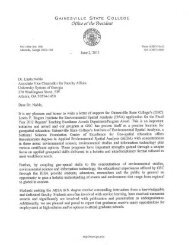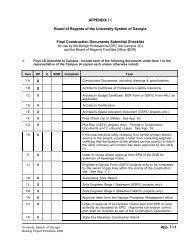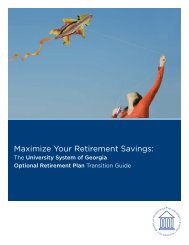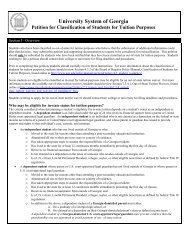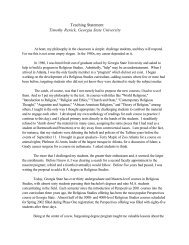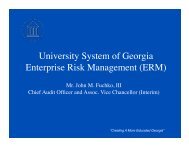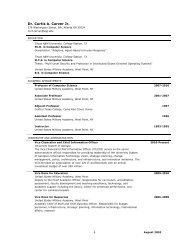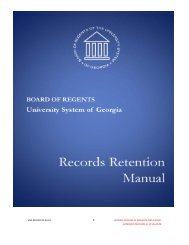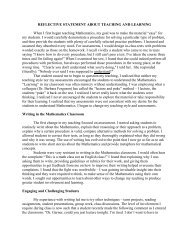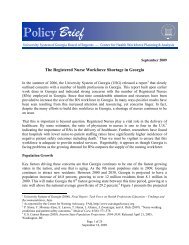WReier-Aviles on DSKGBLS3C1PROD with RULES266856 Federal Register / Vol. 75, No. 209 / Friday, October 29, 2010 / Rules and Regulationscomplete the clock hours that are thebasis for the credit hours awarded in aprogram even when an institutionconverts a program to credit hoursunder the provisions <strong>of</strong> § 668.8(k) and(l). These programs are still required tocontain the clock hours that support theconversion under the regulations, andinstitutions are expected to make surethat those clock hours are completed bythe students, subject to the institution’sexisting policies for excused absencesand make-up classes.We do not agree with the commenterswho believe that § 668.8(k)(2)(iii) doesnot provide for excused absences orwould require 100 percent attendance,because the regulations for clock hourprograms already account for excusedabsences. Section 668.8(k)(2)(iii)specifically accounts for excusedabsences in accordance with the currentregulations in § 668.4(e) which providesguidance on when an institution, indetermining whether a student hassuccessfully completed the clock hoursin a payment period, may include clockhours for which the student has anexcused absence. An institution shouldensure that students taking a program incredit hours are still completing theclock hours associated with theconversion, and excused absences fromthe classes should be within thetolerance permitted in the clock hourregulations. With regard to a leave <strong>of</strong>absence, an institution is expected toensure that a student returning from anapproved leave <strong>of</strong> absence stillcompletes the clock hours that areneeded to support the conversion for theprogram.We do not agree with the commenterwho believed that § 668.8(k)(2)(iii) isimpractical because most institutionsuse a 50-minute instructional hourinstead <strong>of</strong> a 60-minute clock hour. Aclock hour is currently defined in§ 600.2 as (1) a 50- to 60-minute class,lecture, or recitation in a 60-minuteperiod; (2) a 50- to 60-minute facultysupervisedlaboratory, shop training, orinternship in a 60-minute period; or (3)sixty minutes <strong>of</strong> preparation in acorrespondence course. We also do notagree with this commenter’s belief thatthe provision is unclear on whether therelevant clock hours would beconsidered to be provided if noinstructor appeared for the clock hour.If a student is unable to complete aclock hour because the instructor is notpresent, there is no clock hour to becounted towards meeting the requiredclock hours unless it may be counted asan approved absence.Changes: None.Comment: One commenter believedthat the <strong>Department</strong> should clearly statein the final regulations that§ 668.8(k)(2)(iii) is not intended to be atest <strong>of</strong> the reasonable equivalencies thatinstitutions can develop with regard todetermining credit hours as that term isdefined in § 600.2.Discussion: We do not believe it isnecessary to amend § 668.8(k)(2)(iii) tostate that the provision is not intendedto be a test <strong>of</strong> the reasonableequivalencies that institutions candevelop with regard to determiningcredit hours as defined in § 600.2. Thecredit-hour definition in § 600.2specifically excludes its applicability toa program subject to the conversionformula in § 668.8(l).Changes: None.Comment: Many commenters believedthat proposed § 668.8(l) would decreasestudents’ eligibility for title IV, HEAprogram funds. These commentersbelieved that students enrolled in shorttermand nondegree programs measuredin credit hours would unjustlyexperience a decrease in their eligibilityfor title IV, HEA program funds becausethe proposed clock-to-credit-hourconversion would require institutions touse 900 clock hours instead <strong>of</strong> thecurrent 720 clock hours to support thesame amount <strong>of</strong> credit hours.These commenters believed thatstudents’ decreased eligibility wouldforce them to withdraw from short-termand nondegree programs or rely onloans which would increase their debt.One <strong>of</strong> these commenters expressedconcern that the decreased eligibility fortitle IV, HEA program funds woulddisproportionately impactnontraditional and financiallydisadvantaged students.Discussion: We do not agree with thecommenters who believed that studentscurrently enrolled in short-term ornondegree programs would unjustlyexperience a decrease in their eligibilityfor title IV, HEA program funds nor dowe believe that the conversion formulainappropriately impacts students’ titleIV, HEA program eligibility. We do notbelieve that the clock-to-credit-hourconversion rate in current § 668.8(l)provides equitable outcomes forstudents taking similar programsmeasured in clock-hours and credithours. The current regulations result instudents in some credit hour programshaving greater eligibility based on aconversion from clock hours to credithours that assumed student workoutside <strong>of</strong> class is always present in thesame ratio to the time the studentsspend in class. The changes to theconversion formula in § 668.8(l) <strong>of</strong> thesefinal regulations provide for a moreequitable accounting for student workoutside <strong>of</strong> class. New § 668.8(l)(2) wouldVerDate Mar2010 14:10 Oct 28, 2010 Jkt 223001 PO 00000 Frm 00026 Fmt 4701 Sfmt 4700 E:\FR\FM\29OCR2.SGM 29OCR2provide for conversion based on thevarying rates <strong>of</strong> work outside class forparticular educational activities withina student’s courses or program ratherthan mandating the use <strong>of</strong> a constantratio that may be incorrect. Aninstitution applying the appropriateconversion rate to a program inaccordance with § 668.8(l)(1) would beconsidered compliant with § 668.8(l).Changes: None.Comment: Many commenters believedthat the proposed clock-to-credit-hourconversion formula would forceinstitutions to increase the lengths <strong>of</strong>their programs or <strong>of</strong>fer associate’sdegrees in order to retain their eligibilityfor title IV, HEA program funds. Several<strong>of</strong> these commenters believed thatincreasing program lengths would causefinancial hardships for students bydelaying students’ entry into workforceand increasing tuition. A fewcommenters believed that manyprograms would be potentiallyeliminated because <strong>of</strong> the institutionalburden <strong>of</strong> unnecessarily extendingprogram lengths.Discussion: We do not agree withthese commenters. Under the currentregulations in § 668.8(d), public andprivate nonpr<strong>of</strong>it institutions andproprietary institutions <strong>of</strong>feringundergraduate programs may haveeligible programs with a minimum <strong>of</strong>600 clock hours, 16 semester ortrimester hours, or 24 quarter hours. Tothe extent that any short-term programswould not have been eligible for title IV,HEA program funds in the past due tothe inequitable clock-to-credit-hourconversion rate, we believe thatstudents enrolled in these programsshould not have been eligible for titleIV, HEA program funds. Short-termprograms <strong>of</strong>fered in credit hours thatcontained outside work that met orexceeded the assumed outside work thatwas implicit in the conversion shouldbe in compliance with the newrequirements and unaffected by thechange.Changes: None.Comment: A few commentersquestioned how proposed § 668.8(l)would affect institutional creditpolicies. One commenter believed thatprograms that were designed to becompliant with the clock-to-credit-hourconversion ratio for a semester hour incurrent § 668.8(l) cannot be easily orquickly changed because using the ratioalters the delivery, design, andcurricular structure <strong>of</strong> the programs.One commenter requestedclarification <strong>of</strong> how the conversionshould be applied when one programhas courses that require outside workand other courses that do not.
Federal Register / Vol. 75, No. 209 / Friday, October 29, 2010 / Rules and Regulations66857WReier-Aviles on DSKGBLS3C1PROD with RULES2Discussion: We do not believe that itis necessary for programs to changetheir structure or credit assignments foracademic purposes if they are subject tothe conversion formula in new§ 668.8(l); however, institutions areresponsible for ensuring that the credithours awarded for title IV, HEA programpurposes comply with the provisions in§ 668.8(l). In some instances, there maybe no discernable difference betweeninstitutions’ determinations <strong>of</strong> credithours for academic purposes and titleIV, HEA program purposes dependingon the outcome <strong>of</strong> determinations <strong>of</strong>work outside <strong>of</strong> class and instructionalperiods within a program. Someinstitutions may currently award fewercredits then the existing regulationsallow or would be allowed under thefinal regulations.The provisions in § 668.8(l)(2) providean exception to the minimum standardfor converting clock hours to credithours in § 668.8(l)(1) for coursework ina program that qualifies for a lesser rate<strong>of</strong> conversion based on additionalstudent work outside <strong>of</strong> class. In a casewhere a program <strong>of</strong>fers courses withwork outside <strong>of</strong> class, an institutionmust use the standards in § 668.8(l)(1)for the courses without the work outside<strong>of</strong> class and may apply the exception in§ 668.8(l)(2) to courses with workoutside <strong>of</strong> class.Changes: None.Comment: One commenter supportedproposed § 668.8(l)(2) because itprovides institutions the ability toaccount for work outside <strong>of</strong> class. Onecommenter supported the provision, butrecommended that the <strong>Department</strong>specify when an institution is eligible touse work outside <strong>of</strong> class as part <strong>of</strong> thetotal clock-hour calculation.A few commenters asked forclarification regarding proposed§ 668.8(l)(2) and the work outside <strong>of</strong>class that may be combined with clockhours <strong>of</strong> instruction in order to meet orexceed the numeric requirementsestablished in § 668.8(l)(1). Thesecommenters requested clarification onhow institutions should measurestudent’s completion <strong>of</strong> work outside <strong>of</strong>class, whether work outside <strong>of</strong> classshould be identified in course syllabi,whether work outside <strong>of</strong> class should begraded, and what entity shoulddetermine that a program is suited toinclude work outside <strong>of</strong> class.Discussion: Under § 668.8(l)(2), aninstitution may use a determination <strong>of</strong>appropriate amounts <strong>of</strong> work outside <strong>of</strong>class for various educational activitiesin a course or program in determiningthe appropriate conversion rate fromclock hours to credit hours for eacheducational activity in the course orprogram. However, we do not believethat it is appropriate for the <strong>Department</strong>to provide more specificity fordetermining the appropriate conversionrates for various educational activitiesin a course or program. An institution,in accordance with the requirements <strong>of</strong>its designated accrediting agency, orState agency for the approval <strong>of</strong> publicpostsecondary vocational institutions,recognized under 34 CFR 603, isresponsible for making determinations<strong>of</strong> the appropriate credit hours underproposed § 668.8(l)(2). If an institutionis unsure <strong>of</strong> how to apply the provisions<strong>of</strong> § 668.8(l)(2) to a program, it would beconsidered compliant if it uses theappropriate conversion ratio specifiedin § 668.8(l)(1).Changes: None.Comment: One commenter suggestedeliminating the provision in proposed§ 668.8(k)(2)(ii) that requires institutionsto measure student progress in clockhours in any program if the credit hoursawarded for the program are not incompliance with the definition <strong>of</strong> credithour in § 600.2. The commenterbelieved the Secretary’s proposedcredit-hour definition in § 600.2 allowedthe Secretary to interfere in academicmatters.Discussion: The definition <strong>of</strong> credithour in § 600.2 is intended to establisha quantifiable, minimum basis for acredit hour for Federal programpurposes, including the title IV, HEAprograms. We believe that it is necessaryto establish the standards by which aprogram that awards credit hours thatare not in compliance with thedefinition <strong>of</strong> credit hour in § 600.2 maystill be eligible for title IV, HEA programfunds. Thus, § 668.8(k)(2)(ii) providesthat a program that does not awardcredit hours in compliance with § 600.2may still be eligible for title IV, HEAprograms using the underlying clockhours<strong>of</strong> the program.Changes: None.Comment: A few commentersrequested clarification on how toaddress students that are alreadyenrolled in programs that may changethe measurement <strong>of</strong> student progress tocomply with proposed § 668.8(k) and (l).A few <strong>of</strong> these commenters alsorequested additional time to complywith the proposed regulations in thesesections. One commenter requested thatcurrent students should be permitted tocomplete their programs using thecurrent conversion ratio. Onecommenter asked that the Secretaryallow institutions that <strong>of</strong>fered credithourprograms in the 2010–11 academicyear, but will need to measure studentprogress in clock hours under proposed§ 668.8(k)(2)(i)(B), to continueVerDate Mar2010 14:10 Oct 28, 2010 Jkt 223001 PO 00000 Frm 00027 Fmt 4701 Sfmt 4700 E:\FR\FM\29OCR2.SGM 29OCR2measuring student progress in theseprograms using credit hours.One commenter asked whetherinstitutions are required to executerevised Enrollment Agreements withcurrently enrolled students when thenew regulations take effect.One commenter suggested that theconversation rate in § 668.8(l) shouldnot be applied to existing programs forat least one year from July 1, 2011 toallow for accrediting agencies to createprocedures for assessing institutions’assignment <strong>of</strong> credit hours. Thiscommenter added that only newprograms should be required to use theproposed conversion rate.One commenter requested that theproposed provisions in § 668.8(l)(2)(i)not take effect for two award years inorder for institutions that use clockhours to have time to redesign theirprograms.Discussion: We agree with thecommenters’ concerns regarding theapplicability <strong>of</strong> the changes to § 668.8(k)and (l) to students enrolled prior to theeffective date <strong>of</strong> these regulations inprograms affected by the changes in therequirements. We agree that for studentsenrolled in programs subject to theprovisions in § 668.8(k) and (l) as <strong>of</strong> theJuly 1, 2011 effective date <strong>of</strong> these finalregulations, an institution may chooseto apply the regulations in current§ 668.8(k) and (l) until these studentscomplete the program or to applyamended § 668.8(k) and (l) in these finalregulations for all students enrolled inpayment periods or assigned to the2011–12 and subsequent award years.For students who enroll or reenroll onor after July 1, 2011 in programs affectedby changes in § 668.8(k) and (l),institutions must determine title IV,HEA eligibility using § 668.8(k) and (l)in these final regulations.We do not agree that a delay in theeffective date is needed for institutionsto allow institutions more time to bringtheir existing programs into compliance.If an institution’s accrediting agency, orState agency, is not yet compliant withthe provisions <strong>of</strong> § 602.24(f) for anaccrediting agency, or § 603.24(c) for aState agency, the institution must usethe conversion formula in § 668.8(l)(1)<strong>of</strong> these final regulations until the Stateagency and accrediting agency arecompliant.Changes: None.
- Page 1 and 2: Friday,October 29, 2010Part IIDepar
- Page 3 and 4: Federal Register / Vol. 75, No. 209
- Page 6 and 7: 66836 Federal Register / Vol. 75, N
- Page 8 and 9: 66838 Federal Register / Vol. 75, N
- Page 10 and 11: WReier-Aviles on DSKGBLS3C1PROD wit
- Page 12 and 13: 66842 Federal Register / Vol. 75, N
- Page 14 and 15: 66844 Federal Register / Vol. 75, N
- Page 16 and 17: WReier-Aviles on DSKGBLS3C1PROD wit
- Page 18 and 19: 66848 Federal Register / Vol. 75, N
- Page 20 and 21: 66850 Federal Register / Vol. 75, N
- Page 22 and 23: WReier-Aviles on DSKGBLS3C1PROD wit
- Page 24 and 25: 66854 Federal Register / Vol. 75, N
- Page 28 and 29: 66858 Federal Register / Vol. 75, N
- Page 30 and 31: 66860 Federal Register / Vol. 75, N
- Page 32 and 33: 66862 Federal Register / Vol. 75, N
- Page 34 and 35: 66864 Federal Register / Vol. 75, N
- Page 36 and 37: 66866 Federal Register / Vol. 75, N
- Page 38 and 39: WReier-Aviles on DSKGBLS3C1PROD wit
- Page 40 and 41: WReier-Aviles on DSKGBLS3C1PROD wit
- Page 42 and 43: 66872 Federal Register / Vol. 75, N
- Page 44 and 45: WReier-Aviles on DSKGBLS3C1PROD wit
- Page 46 and 47: WReier-Aviles on DSKGBLS3C1PROD wit
- Page 48 and 49: WReier-Aviles on DSKGBLS3C1PROD wit
- Page 50 and 51: 66880 Federal Register / Vol. 75, N
- Page 52 and 53: WReier-Aviles on DSKGBLS3C1PROD wit
- Page 54 and 55: 66884 Federal Register / Vol. 75, N
- Page 56 and 57: 66886 Federal Register / Vol. 75, N
- Page 58 and 59: WReier-Aviles on DSKGBLS3C1PROD wit
- Page 60 and 61: WReier-Aviles on DSKGBLS3C1PROD wit
- Page 62 and 63: WReier-Aviles on DSKGBLS3C1PROD wit
- Page 64 and 65: WReier-Aviles on DSKGBLS3C1PROD wit
- Page 66 and 67: WReier-Aviles on DSKGBLS3C1PROD wit
- Page 68 and 69: WReier-Aviles on DSKGBLS3C1PROD wit
- Page 70 and 71: WReier-Aviles on DSKGBLS3C1PROD wit
- Page 72 and 73: 66902 Federal Register / Vol. 75, N
- Page 74 and 75: WReier-Aviles on DSKGBLS3C1PROD wit
- Page 76 and 77:
WReier-Aviles on DSKGBLS3C1PROD wit
- Page 78 and 79:
66908 Federal Register / Vol. 75, N
- Page 80 and 81:
WReier-Aviles on DSKGBLS3C1PROD wit
- Page 82 and 83:
66912 Federal Register / Vol. 75, N
- Page 84 and 85:
WReier-Aviles on DSKGBLS3C1PROD wit
- Page 86 and 87:
66916 Federal Register / Vol. 75, N
- Page 88 and 89:
WReier-Aviles on DSKGBLS3C1PROD wit
- Page 90 and 91:
WReier-Aviles on DSKGBLS3C1PROD wit
- Page 92 and 93:
WReier-Aviles on DSKGBLS3C1PROD wit
- Page 94 and 95:
66924 Federal Register / Vol. 75, N
- Page 96 and 97:
WReier-Aviles on DSKGBLS3C1PROD wit
- Page 98 and 99:
66928 Federal Register / Vol. 75, N
- Page 100 and 101:
WReier-Aviles on DSKGBLS3C1PROD wit
- Page 102 and 103:
66932 Federal Register / Vol. 75, N
- Page 104 and 105:
WReier-Aviles on DSKGBLS3C1PROD wit
- Page 106 and 107:
66936 Federal Register / Vol. 75, N
- Page 108 and 109:
66938 Federal Register / Vol. 75, N
- Page 110 and 111:
66940 Federal Register / Vol. 75, N
- Page 112 and 113:
66942 Federal Register / Vol. 75, N
- Page 114 and 115:
66944 Federal Register / Vol. 75, N
- Page 116 and 117:
66946 Federal Register / Vol. 75, N
- Page 118 and 119:
WReier-Aviles on DSKGBLS3C1PROD wit
- Page 120 and 121:
WReier-Aviles on DSKGBLS3C1PROD wit
- Page 122 and 123:
WReier-Aviles on DSKGBLS3C1PROD wit
- Page 124 and 125:
66954 Federal Register / Vol. 75, N
- Page 126 and 127:
WReier-Aviles on DSKGBLS3C1PROD wit
- Page 128 and 129:
66958 Federal Register / Vol. 75, N
- Page 130 and 131:
66960 Federal Register / Vol. 75, N
- Page 132 and 133:
WReier-Aviles on DSKGBLS3C1PROD wit
- Page 134 and 135:
WReier-Aviles on DSKGBLS3C1PROD wit
- Page 136 and 137:
WReier-Aviles on DSKGBLS3C1PROD wit
- Page 138 and 139:
66968 Federal Register / Vol. 75, N
- Page 140 and 141:
66970 Federal Register / Vol. 75, N
- Page 142 and 143:
66972 Federal Register / Vol. 75, N
- Page 144 and 145:
66974 Federal Register / Vol. 75, N




